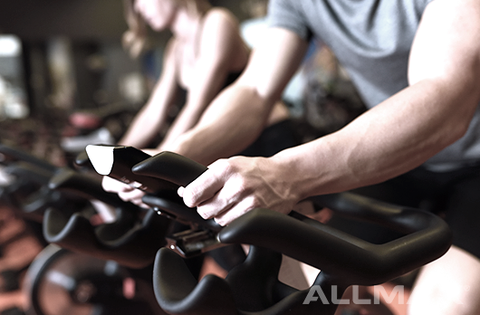A New You Starts Now! Get Shredding Down to a Science this year with our Three-Part investigation into the proven conditioning techniques that will send your metabolism into overdrive, eating habits that will chisel your lower abdomen and supplements to fine-tune any regimen. PART 1:Learn everything you need to know to send your metabolism into overdrive! PART 2: Nutrition for a Shredded Physique
Energy Balance and Training for Fat Loss

The New Year is here! In 2017 it’s important to look good, feel good, and there’s no doubt you probably have some serious fitness resolutions! So pack your gym bag, grab you’re A:CUTS and let’s get going! This year, we will get shredding down to a science and reveal that six-pack you’ve always dreamed of. This article will discuss the science behind getting shredded with proven conditioning techniques that will send your metabolism into overdrive, eating habits that will chisel your lower abdomen and supplements to fine-tune any regimen.
IT’S MORE THAN JUST ENERGY IN ENERGY OUT!Here’s the deal; getting shredded is as simple as “energy out” exceeding “energy in.” However, there are so many variables that define energy in and energy out that it may be difficult to calculate. There are three commonly used approaches when pursuing fat loss. The wrong way, the right way and the best way. Unfortunately, a lot of people with honest intentions fall into the first category – eating sensibly and working out regularly but still without results. This can occur by a number of factors:
- Your training regime – if you’re not working up a sweat, you’re not doing it right!
- Your definition of eating sensibly – avocados are precious but at 15% fat, one at every meal might be just enough to send you overboard.
- Improper supplementation – let’s stay away from empty promises and start using ingredients that are backed by science!
Herein we will present a comprehensive overview of how to do things the right way. But more importantly, how to do things the best way, ensuring the correct approaches are combined and personalized for optimal results.

Daily Caloric Intake to Obtain an Energy Deficit
LET’S START BY TALKING ABOUT ENERGY IN AND ENERGY OUT.
The Wrong Way: NOT Counting Calories
Let’s face it, counting calories is a pain. Keeping track of how much food you’re eating is a hassle, am I right? But wait – think about what you just read, “keeping track of how much food you’re eating,” (i.e. how much energy you’re consuming).The Right Way: Counting Calories
Believe it or not, tracking calories is an important consideration when calculating your energy in versus energy out. Start getting used to this approach to guarantee long-term success.

The Best Way: Counting Calories as it Relates to YOU
Find a calculator online that will consider your age, weight, height and activity level to predict the amount of calories per day required to maintain your current body weight. These are heavily studied equations and some can be so good that they match the values reported by physically measuring your basal metabolic rate (BMR) (1). Once you have obtained your calories, knock 20% off of this number. Some diets prescribe extreme and potentially unhealthy daily caloric restrictions between 800 and 1500 calories per day, regardless of who you are (2). Reducing your daily maintenance calories by 20% is subtle enough to produce weight-loss results without an extreme energy deficit and the associated hunger pangs.
Conditioning to Ramp up your Metabolism and Shred like Never Before
Conditioning is the primary mode of ensuring energy out exceeds energy in. Now that you have a daily caloric intake required to maintain an energy deficit, proper conditioning will ensure you stay in a weight-loss zone and better yet, specifically target fat stores. Remember, the caloric deficit from the previous section includes an assessment of physical activity, so you better be feeling the burn. No pain, no gain!… PROPER CONDITIONING WILL ENSURE YOU STAY IN A WEIGHT-LOSS ZONE AND BETTER YET, SPECIFICALLY TARGET FAT STORES.
The Wrong Way: Barely Breaking a Sweat
Have you ever heard the expression, “sweat is just fat melting away.” Although maybe not scientifically accurate, the idea is there. Sweating is a sign that your heart-rate is up, you’re breathing heavy and you’re burning calories.

The Right Way: Working your Butt OFF
If you’re doing cardio for extended periods of time, you will certainly lose weight by burning enough calories to maintain an energy deficit. For optimal results; however, recent scientific evidence points towards particular modes of exercise that will specifically enhance fat loss.
The Best Way: HIGH Intensity Interval Training, High Intensity Interval Resistance Training
It is commonly understood that to target fat loss, an individual should train somewhere around 60-65% VO2max versus higher intensities floating around 85% VO2max. This idea was birthed from evidence that greater proportions of calories are derived from fat while training at lower intensities (3). However, new evidence has shifted this mindset towards high intensity interval training (HIIT) and high intensity interval resistance training (HIRT). For instance, a HIIT routine of cycling for 20 minutes including 60 seconds at high intensity separated by 60 seconds of active recovery had the same effect on 24h energy expenditure (24h EE) as steady endurance training (END) at moderate intensity for 50 minutes (4). The daily energy expenditure of individuals partaking in 20 minutes of HIIT or 50 minutes of endurance training was 3766 and 3526 calories per day, respectively (4). Thus, the former routine provides a far more efficient method of enhancing daily energy expenditure. If you were to perform the HIIT routine for the same amount of time as END, the presumed outcome is a substantial increase in daily energy expenditure beyond what was seen with END; thus, resulting in accelerated weight-loss.

You may be wondering – although HIIT provided the same 24h EE as endurance training in less time, maybe it was still less efficient at targeting fat stores considering training occurred at higher intensities. If this is what you were thinking, than I commend you, that’s a fantastic thought! However, recent studies have shown that HIIT 3 times per week for 20 minutes including 60 sets of 8s sprinting and 12s active recovery, was superior to steady-state exercise for 40 minutes at 60% Vo2 peak in producing total fat loss after 15 weeks of exercise (5). So good thought, but you just got HIIT with some new knowledge on how to best burn fat (*wink)! The exact mechanisms underlying changes in body composition between steady state cardio and HIIT are unclear. However, a study recently published in 2014 provides some clues for the effect of HIIT on 24H EE. Compared to moderate intensity exercise, athletes who partook in HIIT cardio displayed a significant increase in plasma levels of citric acid cycle (TCA) intermediates (citric acid, aconitic acid and succinic acid) immediately after exercise (6).

The TCA cycle is the final common site of all aerobic processes in human tissue. This includes the metabolism of carbohydrates, protein and lipids for energy, generating about 67% of whole-body energy (7). Thus, increasing TCA activity translates into massive surges of metabolic activity. This is undoubtedly the main driver of 24H EE following HIIT compared to steady cardio.
RETENTION OF LEAN BODY MASS WHILE IN AN ENERGY DEFICIT IS THE KEY TO REVEALING TONED MUSCLES ONCE LAYERS OF EXCESS FAT COME OFF.
Similarly, growth hormone was shown to increase immediately following exercise and at 1h of recovery post-HIIT versus moderate intensity exercise (6). Retention of lean body mass while in an energy deficit is the key to revealing toned muscles once layers of excess fat come off. Growth hormone has been shown to elicit this effect by preserving lean mass and significantly enhancing nitrogen retention during weight loss (8). Additionally, enhanced release of free fatty acids (FFA) from fat tissue and uptake into muscle cells has been demonstrated in response to growth hormone in human studies (9).

Finally, the amino acid, alanine was shown to increase immediately and 1h post-HIIT compared to moderate intensity exercise (6). Studies have shown that administration of alanine in combination with other amino acids significantly enhances serum free fatty acid levels following exercise (10), making them available for uptake into metabolically active tissue. Therefore the key to a successful cardio routine as part of overall conditioning for a shredded physique is to include HIIT cardio. By this method, your body becomes more metabolically active in ways that stimulate the fat burning process. With this conditioning, you’ll burn more fat in half the time, the numbers simply don’t lie!
YOU’LL BURN MORE FAT IN HALF THE TIME, THE NUMBERS SIMPLY DON’T LIE!
When it comes to training for fat loss and abs, cardio always dominates the conversation. You have to lose the fat stores to reveal the abs. This is absolutely true, but a strong resistance training regime always compliments a masterful cardio session. We’ll discuss briefly how to maximize the energy expenditure during resistance training with high intensity interval resistance training. Conditioning for fat loss and revealing elusive abs is all about energy out exceeding energy in. Therefore, to reach your goals the quickest, obtaining maximum fat loss and energy expenditure should be at the heart of physical exertions. In this regard, all resistance training regimes are not created equal.

Take for instance a recent peer reviewed publication that proves HIRT (High Intensity Resistance Training) training is superior to conventional resistance training for optimal fat oxidation (fat burning) and energy utilization (11). Seventeen resistance trained men took part in a HIRT regime that consisted of 22 minutes of training legs, chest and back. The first set was done to 6 rep max (RM) followed by two additional sets, each until failure. Sets were separated by 20 second breaks and exercises were separated by 2 minutes and 30 seconds. One week later, participants conducted traditional training routines (TT) consisting of 52 minutes of 4 sets of 8-12 reps between 70-75% 1RM with 1-2 minutes rest between sets. This routine included bench press, military press, biceps curls, triceps extensions, leg press, leg curls, sit ups and dorsal machine. The resting energy expenditure (REE) of the TT group increased from 1901 calories per day during the recovery period to 1999 calories per day at 22 hours post-exercise. Interestingly, in the HIRT group, REE increased from 1910 to 2362 calories per day at the same time points (11).
COMBINE HIIT WITH THE SECRET INGREDIENT – HIRT, AND YOU’LL BE SHREDDED IN NO TIME!
This is an incredible 363 calorie difference just by switching the mode of resistance training! With that said, in the same study, HIRT was shown to specifically engage fat as a fuel source compared to traditional training at 22 hours post-exercise (11).

Push your output with less time in the gym. Implementing HIRT in your daily conditioning will accelerate weight loss and help shred those last few pounds by enhancing energy expenditure and specifically targeting fat stores. To ensure a recipe for success, combine HIIT with the secret ingredient – HIRT, and you’ll be shredded in no time!
By: Steven Bugiel (IG: @stevieinonstagram) BSc (Food Science and Nutrition); MSc (Biochemistry)
References:
- Mifflin MD, St Jeor ST, Hill LA, Scott BJ, Daugherty SA, Koh YO. 1990. A new predictive equation for resting energy expenditure in healthy individuals. Am J Clin Nutr 51:241-247.
- Finer N. 2001. Low-calorie diets and sustained weight loss. Obes Res 9 Suppl 4:290S-294S.
- Romijn JA, Coyle EF, Sidossis LS, Gastaldelli A, Horowitz JF, Endert E, Wolfe RR. 1993. Regulation of endogenous fat and carbohydrate metabolism in relation to exercise intensity and duration. Am J Physiol 265:E380-391.
- Skelly LE, Andrews PC, Gillen JB, Martin BJ, Percival ME, Gibala MJ. 2014. High-intensity interval exercise induces 24-h energy expenditure similar to traditional endurance exercise despite reduced time commitment. Appl Physiol Nutr Metab 39:845-848.
- Trapp EG, Chisholm DJ, Freund J, Boutcher SH. 2008. The effects of high-intensity intermittent exercise training on fat loss and fasting insulin levels of young women. Int J Obes (Lond) 32:684-691.
- Peake JM, Tan SJ, Markworth JF, Broadbent JA, Skinner TL, Cameron-Smith D. 2014. Metabolic and hormonal responses to isoenergetic high-intensity interval exercise and continuous moderate-intensity exercise. Am J Physiol Endocrinol Metab 307:E539-552.
- Akram M. 2014. Citric acid cycle and role of its intermediates in metabolism. Cell Biochem Biophys 68:475-478.
- Clemmons DR, Snyder DK, Williams R, Underwood LE. 1987. Growth hormone administration conserves lean body mass during dietary restriction in obese subjects. J Clin Endocrinol Metab 64:878-883.
- Jorgensen JO, Moller L, Krag M, Billestrup N, Christiansen JS. 2007. Effects of growth hormone on glucose and fat metabolism in human subjects. Endocrinol Metab Clin North Am 36:75-87.
- Ueda K, Nakamura Y, Yamaguchi M, Mori T, Uchida M, Fujita S. 2016. Amino Acid Mixture Enriched With Arginine, Alanine, and Phenylalanine Stimulates Fat Metabolism During Exercise. Int J Sport Nutr Exerc Metab 26:46-54.
- Paoli A, Moro T, Marcolin G, Neri M, Bianco A, Palma A, Grimaldi K. 2012. High-Intensity Interval Resistance Training (HIRT) influences resting energy expenditure and respiratory ratio in non-dieting individuals. J Transl Med 10:237.
- Helms ER, Zinn C, Rowlands DS, Brown SR. 2014. A systematic review of dietary protein during caloric restriction in resistance trained lean athletes: a case for higher intakes. Int J Sport Nutr Exerc Metab 24:127-138.
- Hill JO, Peters JC, Reed GW, Schlundt DG, Sharp T, Greene HL. 1991. Nutrient balance in humans: effects of diet composition. Am J Clin Nutr 54:10-17.
- Horowitz JF, Mora-Rodriguez R, Byerley LO, Coyle EF. 1997. Lipolytic suppression following carbohydrate ingestion limits fat oxidation during exercise. Am J Physiol 273:E768-775.
- Cermak NM, van Loon LJ. 2013. The use of carbohydrates during exercise as an ergogenic aid. Sports Med 43:1139-1155.
- Wu CL, Nicholas C, Williams C, Took A, Hardy L. 2003. The influence of high-carbohydrate meals with different glycaemic indices on substrate utilisation during subsequent exercise. Br J Nutr 90:1049-1056.
- Horowitz JF, Klein S. 2000. Lipid metabolism during endurance exercise. Am J Clin Nutr 72:558S-563S.
- Weigle DS, Breen PA, Matthys CC, Callahan HS, Meeuws KE, Burden VR, Purnell JQ. 2005. A high-protein diet induces sustained reductions in appetite, ad libitum caloric intake, and body weight despite compensatory changes in diurnal plasma leptin and ghrelin concentrations. Am J Clin Nutr 82:41-48.
- Roberts SB. 2003. Glycemic index and satiety. Nutr Clin Care 6:20-26.
- Bell SJ, Goodrick GK. 2002. A functional food product for the management of weight. Crit Rev Food Sci Nutr 42:163-178.
- Moyer AE, Rodin J, Grilo CM, Cummings N, Larson LM, Rebuffe-Scrive M. 1994. Stress-induced cortisol response and fat distribution in women. Obes Res 2:255-262.
- Wankhede S, Langade D, Joshi K, Sinha SR, Bhattacharyya S. 2015. Examining the effect of Withania somnifera supplementation on muscle strength and recovery: a randomized controlled trial. J Int Soc Sports Nutr 12:43.
- Jeukendrup AE, Randell R. 2011. Fat burners: nutrition supplements that increase fat metabolism. Obes Rev 12:841-851.
- Maeda H, Hosokawa M, Sashima T, Takahashi N, Kawada T, Miyashita K. 2006. Fucoxanthin and its metabolite, fucoxanthinol, suppress adipocyte differentiation in 3T3-L1 cells. Int J Mol Med 18:147-152.
- Flanagan J, Bily A, Rolland Y, Roller M. 2014. Lipolytic activity of Svetol(R), a decaffeinated green coffee bean extract. Phytother Res 28:946-948.
- McCarty MF. 2002. Pre-exercise administration of yohimbine may enhance the efficacy of exercise training as a fat loss strategy by boosting lipolysis. Med Hypotheses 58:491-495.
- Janssens PL, Hursel R, Martens EA, Westerterp-Plantenga MS. 2013. Acute effects of capsaicin on energy expenditure and fat oxidation in negative energy balance. PLoS One 8:e67786.
- Whiting S, Derbyshire EJ, Tiwari B. 2014. Could capsaicinoids help to support weight management? A systematic review and meta-analysis of energy intake data. Appetite 73:183-188.
- Schubert MM, Hall S, Leveritt M, Grant G, Sabapathy S, Desbrow B. 2014. Caffeine consumption around an exercise bout: effects on energy expenditure, energy intake, and exercise enjoyment. J Appl Physiol (1985) 117:745-754.
- Sinha RA, Farah BL, Singh BK, Siddique MM, Li Y, Wu Y, Ilkayeva OR, Gooding J, Ching J, Zhou J, Martinez L, Xie S, Bay BH, Summers SA, Newgard CB, Yen PM. 2014. Caffeine stimulates hepatic lipid metabolism by the autophagy-lysosomal pathway in mice. Hepatology 59:1366-1380.
- Chen SC, Lin YH, Huang HP, Hsu WL, Houng JY, Huang CK. 2012. Effect of conjugated linoleic acid supplementation on weight loss and body fat composition in a Chinese population. Nutrition 28:559-565.
- Lehnen TE, da Silva MR, Camacho A, Marcadenti A, Lehnen AM. 2015. A review on effects of conjugated linoleic fatty acid (CLA) upon body composition and energetic metabolism. J Int Soc Sports Nutr 12:36.



